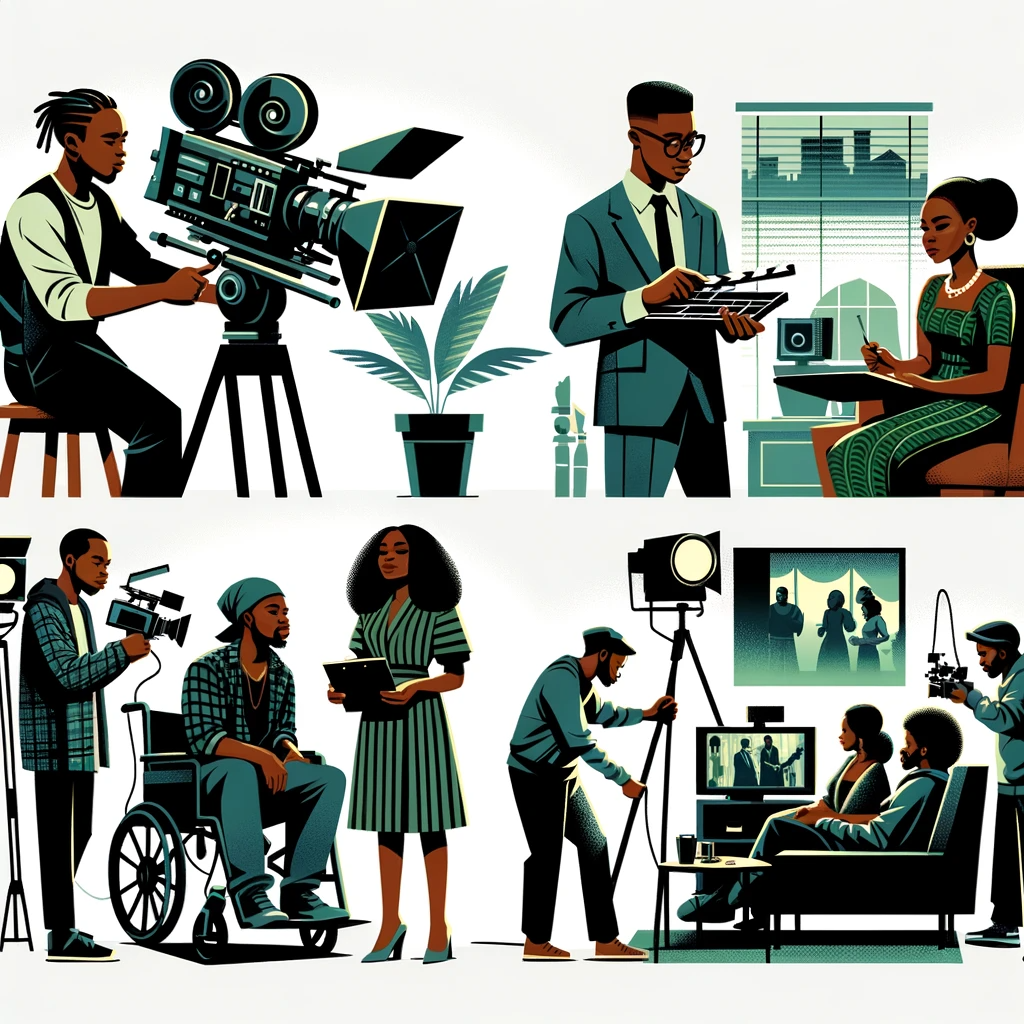Table of Contents
Cinematography is the language of film—the way stories are told not just with dialogue, but with light, movement, and framing. In Nollywood, where visual storytelling is evolving rapidly alongside growing budgets and global ambitions, the art of cinematography is more important than ever.
This guide introduces you to the foundational principles of cinematography, the tools Nigerian filmmakers use, and the creative decisions that shape how a story feels on screen.
What Is Cinematography?
Cinematography is the craft of capturing moving images that visually express a story’s mood, tone, and meaning. It’s more than just operating a camera—it’s about using light, composition, movement, and lens choices to immerse the viewer in the world of the film.
In Nigerian filmmaking, where stories range from gritty urban dramas to rich historical epics, cinematography helps each narrative come alive through a uniquely African visual lens.
The Cinematographer’s Role on a Nollywood Set
The cinematographer—also known as the Director of Photography (DP)—leads the camera and lighting team. They:
- Collaborate closely with the director to define the film’s visual tone
- Choose the right lenses, lighting styles, and camera movement for each scene
- Supervise the gaffers, camera operators, and grips on set
- Maintain visual consistency throughout the film
In Nollywood, DPs often work with tight resources, so they must blend artistry with efficiency.
Core Principles of Cinematography
1. Camera Placement and Framing
- Low angles can show power or danger.
- High angles suggest vulnerability.
- Close-ups draw us into emotional moments.
- Wide shots establish setting and atmosphere.
2. Camera Movement
- Panning follows a character or reveals space.
- Tracking shots move with the subject to create immersion.
- Handheld shots add intensity or realism.
- Drones offer grand perspectives often seen in Nollywood thrillers or adventure films.
3. Composition
- Use of the rule of thirds, headroom, and lead space to guide the viewer’s eye.
- Framing subjects with doors, windows, or light sources to enhance emotional context.
4. Lighting Techniques
Lighting creates mood. Nollywood DPs often rely on portable LED panels, reflectors, and practical lights to achieve:
- High-key lighting (bright, soft): great for comedies and romance.
- Low-key lighting (shadows, contrast): ideal for thrillers or dramatic moments.
- Natural lighting for grounded, documentary-style storytelling.

Cinematography Tools for Nigerian Filmmakers
Cameras
- DSLRs like the Canon 5D or Sony A7 series are budget-friendly choices.
- Cinema cameras like the Blackmagic URSA Mini and RED Komodo are growing in use for high-end productions.
Lenses
- Wide-angle lenses (14mm–35mm) are used to show space and scale.
- Telephoto lenses (85mm–200mm) compress space and isolate subjects.
- Prime lenses offer sharper quality than zooms and are often preferred for their light sensitivity.
Support Gear
- Tripods and monopods for stability.
- Gimbals and dollies for movement.
- Drones for aerial footage.
- LED lights, flags, and diffusers for lighting control.
Cinematography as Visual Storytelling
A good DP doesn’t just shoot what’s in front of them—they help tell the story. For example:
- Slow tracking shots can mirror emotional distance or curiosity.
- Silhouettes can add mystery or symbolism.
- Warm color grading creates nostalgia, while cool tones signal detachment or melancholy.
- In romantic dramas, soft focus and backlighting enhance intimacy.
Each choice serves the script.
The Evolution of Cinematography in Nollywood
In early Nollywood, cinematography was limited by technology and speed. Most films relied on static cameras and minimal lighting. But with streaming platforms, cinema runs, and international co-productions rising, so are the standards.
Today’s Nollywood is investing more in:
- Diverse lighting setups
- Color grading
- Longer takes and steadier shots
- Carefully planned blocking and movement
Films like King of Boys 2, A Ghetto Love Story, and Ajosepo are excellent studies in modern Nigerian cinematography.
Tips for Aspiring Cinematographers in Nigeria
1. Start Small
Use whatever camera you have access to—even a smartphone. Learn to compose well and light naturally.
2. Watch With Intention
Study Nigerian films frame by frame. Ask: Why was this shot used? What mood does the lighting create?
3. Build a Visual Library
Collect images and color palettes that inspire you. Practice recreating scenes from your favorite films.
4. Collaborate
Volunteer on sets, even as an assistant. Learn how real shoots run.
5. Build a Reel
Show your best work in short clips. Keep it tight, cinematic, and story-driven.
Final Thoughts
Cinematography is where craft meets feeling. In Nollywood, it’s not just about looking good—it’s about helping a story land.
So whether you’re shooting on a phone or behind a cinema rig, remember this: the camera is your voice. Learn how to use it with intention.
Because in film, what you see—shapes what you feel.
















Leave a comment